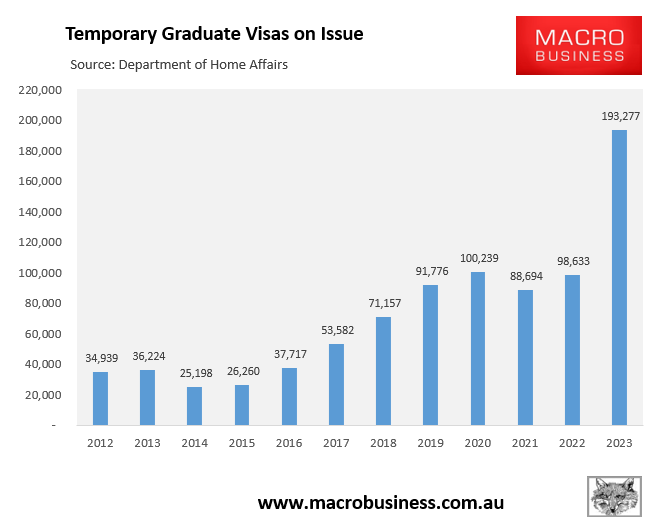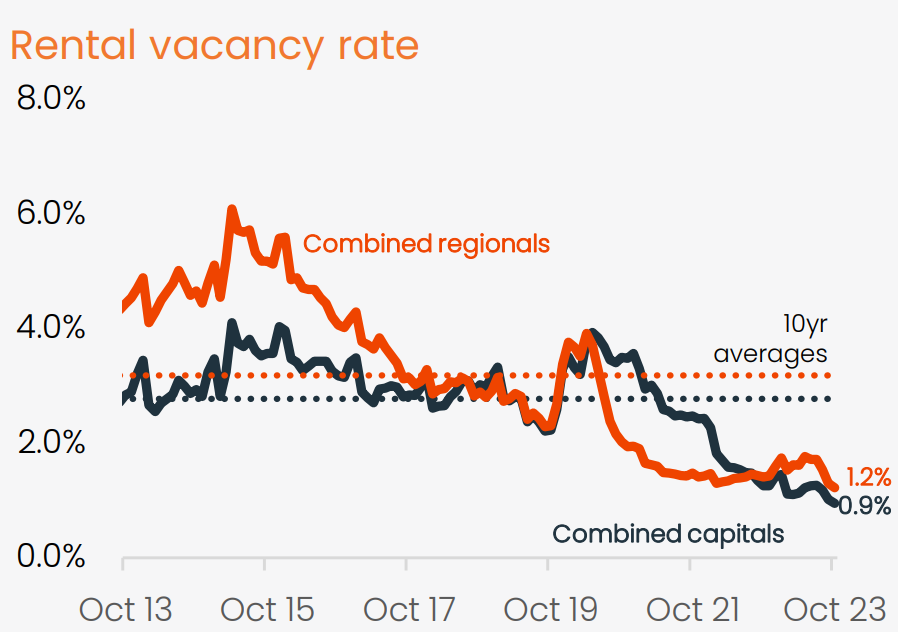Australia is currently experiencing unprecedented inflows of international students.
According to the latest temporary visa data from the Department of Home Affairs, there were a record 664,200 student visas on issue in September, representing a 306,300 annual increase:

Student visa numbers in September were around 110,000 higher than the September 2019 peak.
Meanwhile, graduate visas are also at record levels, with 193,300 on issue in September, up around 95,000 year-on-year:

This means that around one-in-30 people in Australia in September were one either a student or graduate visa – an extraordinary number.
The massive increase in foreign students has contributed to the record tightening in the rental market, which has seen capital city rental vacancy rates collapse to just 0.9% alongside strong rental inflation.

Source: CoreLogic
Given these unprecedented population pressures, The Australian’s economics contributor, Judith Sloan, has called for “a rigorous assessment of the benefits and costs of international education for the country to assess where we go from here”:
“The overall story is one of runaway and uncontrolled growth in international student numbers, pumping up population growth and putting pressures on the cities to which they flock”.
“A very large number of these students intend to stay in Australia permanently or for at least a decade”.
“Recent changes to the student visa conditions have made Australia an even more attractive destination given the guaranteed graduate visas and liberal work rights attached to student visas”.
“The additional resources given to the Department of Home Affairs have sped up significantly the process of granting visas”.
“The federal government recently decided that bachelor degree graduates could stay for four years, up from two; masters graduates could stay for five years, up from three; and PhD graduates could stay for six years, up from four”.
“International students no longer are required to hide their ambition to stay in the country to obtain a visa”…
“It’s time to apply the brakes and ensure the visa arrangements, as well as the conduct of our educational institutions, work for the national interest rather than for sectional ones”.
Clearly, the federal government should place a cap on international student numbers, which have grown to unsustainable levels.
This could be done by limiting international students to a maximum percentage of enrolments within both courses and institutions.
Numbers could also be effectively capped by requiring universities to provide on-campus accommodation to students in proportion to the number of enrolments.
This policy would take direct pressure off Australia’s private rental market and ensure that the costs and benefits to universities and Australians from international student enrolments are more aligned.
Other ways to lower international student numbers could involve:
- Tightening entry requirements, including English-language proficiency and proof of finances.
- Tightening licensing and performance standards for private colleges.
- Penalising poorly performing institutions and closing down ‘ghost colleges’.
- Capping the amount of finder fees and kickbacks that can be paid by institution to education and migration agents.
- Reducing the generosity of work rights for international students and graduates.
- Charging institutions a levy per international student enrolled to ensure that Australians receive a financial cut from the trade, similar to how a sovereign wealth fund collects revenue from mineral exports.
In short, Australia must aim for a smaller number of high-quality students.
We must also stop universities and private colleges from privatising the gains from record international student enrollments while the costs are borne by Australians at large, most notably renters.
Sadly, we have little hope of the federal government capping numbers, given that it recently signed two migration pacts with India with the explicit aim of boosting the number of Indians studying, living and working in Australia.

